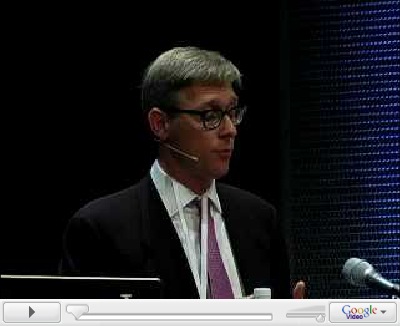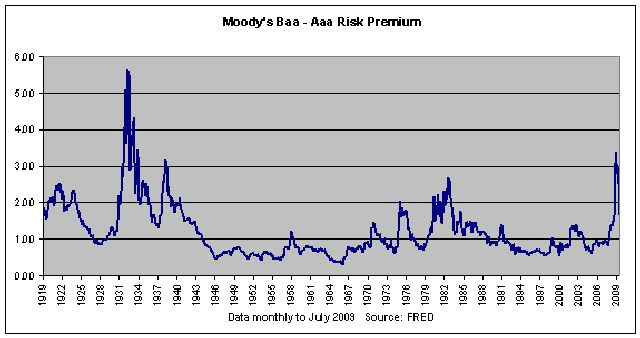With fear still close to generational highs there is a danger of getting stuck in a self-reinforcing loop of repeating the same behavior patterns over and over again… as our policymakers seem to be doing.
Brain Is a Co-Conspirator in a Vicious Stress Loop
By NATALIE ANGIER
If after a few months’ exposure to our David Lynch economy, in which housing markets spontaneously combust, coworkers mysteriously disappear and the stifled moans of dying 401(k) plans can be heard through the floorboards, you have the awful sensation that your body’s stress response has taken on a self-replicating and ultimately self-defeating life of its own, congratulations. You are very perceptive. It has.
As though it weren’t bad enough that chronic stress has been shown to raise blood pressure, stiffen arteries, suppress the immune system, heighten the risk of diabetes, depression and Alzheimer’s disease and make one a very undesirable dinner companion, now researchers have discovered that the sensation of being highly stressed can rewire the brain in ways that promote its sinister persistence.
Reporting earlier this summer in the journal Science, Nuno Sousa of the Life and Health Sciences Research Institute at the University of Minho in Portugal and his colleagues described experiments in which chronically stressed rats lost their elastic rat cunning and instead fell back on familiar routines and rote responses, like compulsively pressing a bar for food pellets they had no intention of eating.
Moreover, the rats’ behavioral perturbations were reflected by a pair of complementary changes in their underlying neural circuitry. On the one hand, regions of the brain associated with executive decision-making and goal-directed behaviors had shriveled, while, conversely, brain sectors linked to habit formation had bloomed.
In other words, the rodents were now cognitively predisposed to keep doing the same things over and over, to run laps in the same dead-ended rat race rather than seek a pipeline to greener sewers. “Behaviors become habitual faster in stressed animals than in the controls, and worse, the stressed animals can’t shift back to goal-directed behaviors when that would be the better approach,” Dr. Sousa said. “I call this a vicious circle.”
Robert Sapolsky, a neurobiologist who studies stress at Stanford University School of Medicine, said, “This is a great model for understanding why we end up in a rut, and then dig ourselves deeper and deeper into that rut.”
The truth is, Dr. Sapolsky said, “we’re lousy at recognizing when our normal coping mechanisms aren’t working. Our response is usually to do it five times more, instead of thinking, maybe it’s time to try something new.”
And though perseverance can be an admirable trait and is essential for all success in life, when taken too far it becomes perseveration — uncontrollable repetition — or simple perversity. “If I were to try to break into the world of modern dance, after the first few rejections the logical response might be, practice even more,” said Dr. Sapolsky, the author of “Why Zebras Don’t Get Ulcers,” among other books. “But after the 12,000th rejection, maybe I should realize this isn’t a viable career option.”
Happily, the stress-induced changes in behavior and brain appear to be reversible. To rattle the rats to the point where their stress response remained demonstrably hyperactive, the researchers exposed the animals to four weeks of varying stressors: moderate electric shocks, being encaged with dominant rats, prolonged dunks in water. Those chronically stressed animals were then compared with nonstressed peers. The stressed rats had no trouble learning a task like pressing a bar to get a food pellet or a squirt of sugar water, but they had difficulty deciding when to stop pressing the bar, as normal rats easily did.
But with only four weeks’ vacation in a supportive setting free of bullies and Tasers, the formerly stressed rats looked just like the controls, able to innovate, discriminate and lay off the bar. Atrophied synaptic connections in the decisive regions of the prefrontal cortex resprouted, while the overgrown dendritic vines of the habit-prone sensorimotor striatum retreated.
According to Bruce S. McEwen, head of the neuroendocrinology laboratory at Rockefeller University, the new findings offer a particularly elegant demonstration of a principle that researchers have just begun to grasp. “The brain is a very resilient and plastic organ,” he said. “Dendrites and synapses retract and reform, and reversible remodeling can occur throughout life.”
Stress may be most readily associated with the attosecond pace of postindustrial society, but the body’s stress response is one of our oldest possessions. Its basic architecture, its linked network of neural and endocrine organs that spit out stimulatory and inhibitory hormones and other factors as needed, looks pretty much the same in a goldfish or a red-spotted newt as it does in us.
The stress response is essential for maneuvering through a dynamic world — for dodging a predator or chasing down prey, swinging through the trees or fighting off disease — and it is itself dynamic. As we go about our days, Dr. McEwen said, the biochemical mediators of the stress response rise and fall, flutter and flare. “Cortisol and adrenaline go up and down,” he said. “Our inflammatory cytokines go up and down.”
The target organs of stress hormones likewise dance to the beat: blood pressure climbs and drops, the heart races and slows, the intestines constrict and relax. This system of so-called allostasis, of maintaining control through constant change, stands in contrast to the mechanisms of homeostasis that keep the pH level and oxygen concentration in the blood within a narrow and invariant range.
Unfortunately, the dynamism of our stress response makes it vulnerable to disruption, especially when the system is treated too roughly and not according to instructions. In most animals, a serious threat provokes a serious activation of the stimulatory, sympathetic, “fight or flight” side of the stress response. But when the danger has passed, the calming parasympathetic circuitry tamps everything back down to baseline flickering.
In humans, though, the brain can think too much, extracting phantom threats from every staff meeting or high school dance, and over time the constant hyperactivation of the stress response can unbalance the entire feedback loop. Reactions that are desirable in limited, targeted quantities become hazardous in promiscuous excess. You need a spike in blood pressure if you’re going to run, to speedily deliver oxygen to your muscles. But chronically elevated blood pressure is a source of multiple medical miseries.
Why should the stressed brain be prone to habit formation? Perhaps to help shunt as many behaviors as possible over to automatic pilot, the better to focus on the crisis at hand. Yet habits can become ruts, and as the novelist Ellen Glasgow observed, “The only difference between a rut and a grave are the dimensions.”
It’s still August. Time to relax, rewind and remodel the brain.















